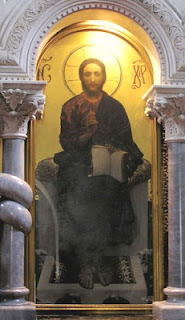"The Blessed Virgin Mary With Child" by Mikhail Alexandrovich Vrubel is a masterpiece of Russian painting. This icon is a home for a part of soul of wonderful real Artist who was able to feel and see things not seen by others.
The
icon is painted against golden background, in deep velvet dark red tones, a
pearl embroidered pillow is at the altar, tender roses are at the foot. However,
the artwork details are of no importance. Marvellous
face of the Blessed Virgin Mary takes up attention completely, and one has eyes
glued to it. Having infant Jesus on her lap, she is
gazing sadly and wisely.
THE ORIGIN OF THE ICON

The year of 1884. Mikhail Vrubel, a 28-year-old student of St. Petersburg Academy of Arts, among others is invited to

Rumours reach Professor Prakhov that his wife has got a young admirer. To prevent further development of their romantic relationship, he suggests that Vrubel should go to
 In
Venice Vrubel spends about half a year. Despite the fact that the artist owes significant part
of his creative development to
In
Venice Vrubel spends about half a year. Despite the fact that the artist owes significant part
of his creative development to
Returning
to Kiev
It remains an enigma whether Vrubel has made a declaration of love. Vrubel takes the following cold attitude of Emilia Lvovna heavily and, in spite of started works of painting of St. Volodymir's Cathedral, leaves forOdessa Kiev
The image of Prakhova will keep haunting the artist for a long time. It is widely presumed that Emilia Lvovna inspired Vrubel not only for the representation of the Blessed Virgin Mary's face on an icon in Church of St. Cyril, but also for Demon images at which the artist kept working during all his life (but this story concerns other masterpieces). Although all presently known "Demons" have been created much later, their concept and start are referred exactly to theKiev Kiev
It remains an enigma whether Vrubel has made a declaration of love. Vrubel takes the following cold attitude of Emilia Lvovna heavily and, in spite of started works of painting of St. Volodymir's Cathedral, leaves for
The image of Prakhova will keep haunting the artist for a long time. It is widely presumed that Emilia Lvovna inspired Vrubel not only for the representation of the Blessed Virgin Mary's face on an icon in Church of St. Cyril, but also for Demon images at which the artist kept working during all his life (but this story concerns other masterpieces). Although all presently known "Demons" have been created much later, their concept and start are referred exactly to the
Vrubel's creative work has repeatedly undergone sharp changes in modern estimates as well, since it failed to comply with the accepted frames. It was not until 1960-ies that Vrubel's unrepeatable individuality again caused heightened interest, and in 1980-ies studies were published which objectively assessed creative work of the master as one of the most bright artists of late XIX - early XX centuries.
Materials on the subject:
1.Museum "Church of St. Cyril" - a monument of architecture of the XIIcentury
.2. Wikipedia - The Blessed Virgin Mary With Child (Vrubel).
3. N.Shebarshina. "Crazy genius presented the Blessed Virgin Mary to Kiev".
4. O.Onguryan."When image of the Blessed Virgin Mary painted by Vrubel appeared inChurch of St. Cyril, Kiev residents recognized in it the features of a womanwell-known in Kiev"
5. Vrubel world.
6. About love, fair ladyand "The Blessed Virgin Mary".
7. Online Movies. "Essays on Vrubel".


